Guppies are common in many different aquariums, but most tank owners don’t realize they come in many more varieties than just the common guppy.
Understanding your guppy type will help you set up your tank for the best results!
The guppy family includes the Common Guppy, Endlers, and Swamp Guppies. Guppies are also broken up into tail types, which may include the fantail, roundtail, and flagtail.
Each species of guppy has its own care requirements, and recognizing what your guppy needs will help you take better care of them.
Keep reading, because I’m going to give a breakdown of each guppy species, their care instructions, and how they differ from one another.

Table of Contents
What Types of Guppies Are There?
Guppies are a widely distributed tropical fish known for their high energy and prolific breeding. Also called millionfish and rainbow fish, this American native is very popular in aquariums, but not all guppies are the same.
All guppy species prefer to shoal with others of their kind, preferably in groups of 6 or more. Similarly, guppies should be implemented into a tank at a 1:3 male-to-female ratio to spread out aggression among females.
Poecilia Reticulata (Common Guppy)
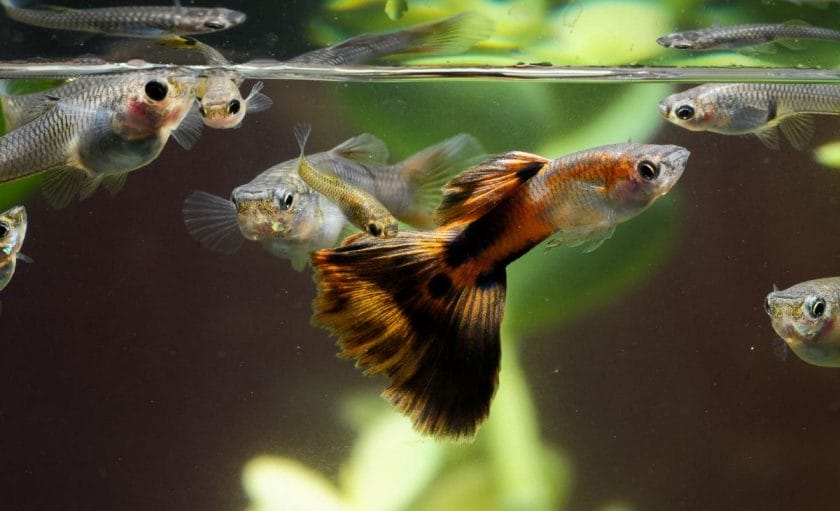
Also called the fancy guppy, the common guppy is the most familiar to aquarists and the one that is most commonly bred into various different strains, which may involve changes in color, patterns, tail types, and other genetic traits.
In general, males are more colorful than their female counterparts, although in some strains, the females are equally as beautiful, if not uniquely more so. This sexual dimorphism aids in mating, and the males will flare and display their fins.
Generally, males and females should be kept at a 1:3 ratio to spread aggression, as males will regularly chase females with intent to mate.
Common guppies mate and reproduce often in a practice known as polyandry, wherein a female will mate with multiple males to produce offspring. Guppies are livebearers, which means that you might see the gavel (a dark spot) on the female guppy’s protruding underbelly one day and guppy fry the next!
These fry often are subject to predation, even by their own parents. Most fish will eat guppy fry given the chance, so if you want your guppies to survive, it’s best to put them in a separate tank.
Overview
Here’s a quick breakdown of the Common Guppy and their attributes.
| Scientific Name | Poecilia Reticulata |
| Care Level | Easy |
| Temperament | Peaceful |
| Max Size | 2.5 inches (females bigger than males) |
| Temperature | 65-80 F |
| pH | 6.7-7.8 |
| Minimum Tank Size | 5 gallons |
| Diet | Omnivore |
| Group Size | 3+ (preferably 6+) |
| Shoaling | Yes |
| Swimming Level | Middle-Top |
Tank Environment
As mentioned, guppies are easily picked on by other fish, even ones that are known to be peaceful. To reduce stress in an aquarium environment, it’s recommended to have lots of plants as hiding places.
Here are some suggestions:
- Hornwort
- Amazon Sword
- Cryptwenty
- Guppy Grass
These plants not only oxygenate your tank, but they can also help give fry a fighting chance to survive, although if you’re breeding, you should set up a separate tank.
Sand is an ideal substrate, as it is fine enough to not be a hazard for guppies.
Filtration
Filtration is an essential part of guppy care. A sponge or corner filter can help reduce bacteria and algae buildup, as well as convert harmful compounds into less harmful ones.
Low Water Flow
Males sometimes have long, flowy fins depending on their tail type, which makes swimming difficult. Guppies are weak swimmers in general, so it’s important that your filter isn’t too powerful. Sponge and corner filters are ideal due to their gentle water flow, although adjustable hang-on back filters are okay, too.
Canister filters, while extremely efficient at biological, mechanical, and chemical filtration, often have a strong water flow, which is something to consider.
Feeding Schedule
Guppies are omnivores and will eat a wide variety of foods, including:
- Algae
- Diatoms
- Invertebrates
- Detritus
Flake foods are fine, too, as are live foods like daphnia, brine shrimp, and blood worms.
Common Parasites and Infections
Guppies are prone to some diseases and parasites. Swim bladder disease can affect any tank, but beginner aquarists may face this issue more commonly. Swim bladder disease can be caused by rapid overeating or a buildup of nitrate or ammonia.
Check your water parameters and adjust your feeding schedule accordingly.
Ich is another disease that is common in fish tanks and can strike unexpectedly. Evidenced by tiny white spots on your fish, ich is a parasite that can spread rapidly. To treat, increase the temperature of the aquarium to speed up the life cycle of the parasite and introduce an appropriate medication.
Poecilia Wingei (Endlers)

Endlers are a close relative to guppies and will regularly hybridize with common guppies. Endlers are a little harder to get ahold of, although some pet stores and specialty shops may sell them.
They are native to Venezuela and share many characteristics with common guppies. The males tend to be smaller, for example, and have brighter colors. There are also some important differences. Endlers tend to be a little smaller, while the common guppy appears stockier.
They usually have forked fins, while common guppies may have a wider tail with more color. That being said, endlers often have extremely vibrant metallic pigmentation on their bodies
Overview
Here’s a basic overview of Endlers:
| Scientific Name | Poecilia Wingei |
| Care Level | Easy |
| Temperament | Peaceful |
| Max Size | 1.8 inches |
| Temperature | 72-78 F |
| pH | 6.7-8.5 |
| Minimum Tank Size | 10 gallons |
| Diet | Omnivore |
| Group Size | 3+ |
| Shoaling | Yes |
| Swimming Level | Middle-Top |
Tank Environment
Endlers also need a safe environment away from other endlers and other fish. Tall grass, ferns, or plants are great for providing hiding spots. Preferably, you should keep endlers in groups of at least 3, although 6 or more is preferable.
Filtration
As with guppies, endlers need a filter that can handle the waste they produce; otherwise, water parameters will be out of line. Use a sponge or corner filter suited to the size of your tank and test regularly using this test kit, which can help you keep your pH, ammonia, nitrite, and nitrate in check.
Water Flow
Low water flow is important for endlers because they are small and don’t have powerful fins. Less so than common guppies, whose long, flowy fins are more of a hassle.
Still, they are small fish, and it’s important to monitor and adjust your water flow so that your endlers aren’t being pushed all over the place by the current, as it can be stressful or even dangerous.
Feeding Schedule
Endlers are omnivores and will eat detritus and plant matter, including frozen or live food, pellets, flakes, veggies, brine shrimp, blood worms, and daphnia. Feed daily and adjust so that you have no leftover food after 30-60 minutes. If you do, remove the excess food and feed less next time.
Common Parasites and Infections
The endler species isn’t prone to any specific parasite or infection, which is a testament to their strong immune system; still, parasites like ich can still affect an endler tank. Gill disease and fin rot are common beginner ailments and can be treated by monitoring and adjusting tank parameters.
Dropsy is another concern for guppy species, which is a bacterial infection usually caused by poor water parameters and can be extremely deadly.
Micropoecilia Picta (Swamp Guppies)

Swamp guppies are more of a distant relative of guppies and endlers; in fact, swamp guppies can be found in (you guessed it) swamp and brackish marshland. They are native to Central and South America.
They are very delicate and not recommended for beginner aquarists, as it’s very hard to keep them in good health. As with other guppy species, males are distinguished by their striking coloration and smaller size.
Swamp guppies are rare and highly sought after, comprising a relatively small portion of the many, many different types of guppies in the species.
Overview
If you’re going to care for swamp guppies, having a good deal of aquarium experience under your belt is extremely helpful.
Here’s some information to get you started:
| Scientific Name | Micropoecilia Picta |
| Care Level | Hard |
| Temperament | Peaceful |
| Max Size | 1.2 inches |
| Temperature | 72-82 F |
| pH | 6.7-8.5 |
| Minimum Tank Size | 10 gallons |
| Diet | Omnivore |
| Group Size | 8+ |
| Shoaling | Yes |
| Swimming Level | Middle-Top |
Tank Environment
As mentioned, swamp guppies can live in brackish or marshland waters; the key factor is stability. They can be very sensitive, which is why it’s important to keep parameters in check.
They strongly prefer dense aquatic vegetation to mimic their natural environment, which is both shelter and food to swamp guppies.
Filtration
Swamp guppies need adequate filtration to thrive, as well as gentle water flow to stay healthy.
Diet
Swamp guppies are omnivorous, but they prefer plant-based foods like algae. They will eat mosquito larvae, crustations, flakes, pellets, and live, frozen, or freeze-dried foods.
Parasites and Infections
Swamp guppies are susceptible to fin rot, ich, dropsy, and swim bladder disease, much like other guppies. Because swamp guppies have stricter parameters, they may be more susceptible to diseases brought on by stress.
As such, it’s imperative that your water parameters are within optimal ranges if you are keeping swamp guppies.
Guppy Tail Types
One of the key distinctions among guppies is their tail type. While guppies with different tail types are still classified under Poecilia Reticulata, the differences can make the fish appear much different.
It’s important to note that these tail types are not exhaustive; breeders are constantly experimenting with new and even more aesthetic tails! As mentioned before, males tend to exhibit these aesthetic traits more prominently than females.
It’s also important to note that it can be nigh impossible to determine the exact species mix of a guppy, due to the sheer number of genetic factors that go into breeding; however, some factors can be more readily distinguished.
Veiltail Guppies
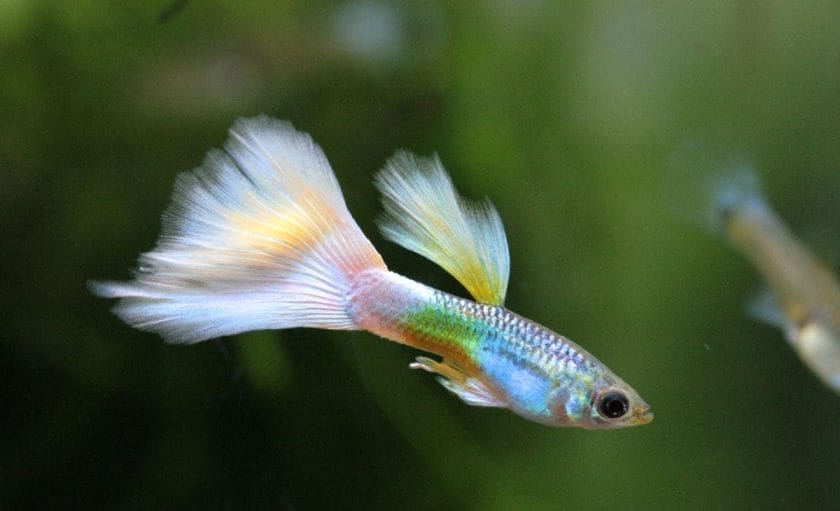
Veiltail guppies have elongated dorsal and ventral fins with a flowing tail. This distinctive tail pattern is wavy and beautiful, giving a veiltail guppy a very distinctive elegant look.
Halfmoon Tail Guppies

Halfmoon guppies are among the most popular for breeders and aquarists, likely because the halfmoon shape compliments their beautiful patterns. The tail begins wide at the base and meets at a rounded end.
Delta Tail Guppies
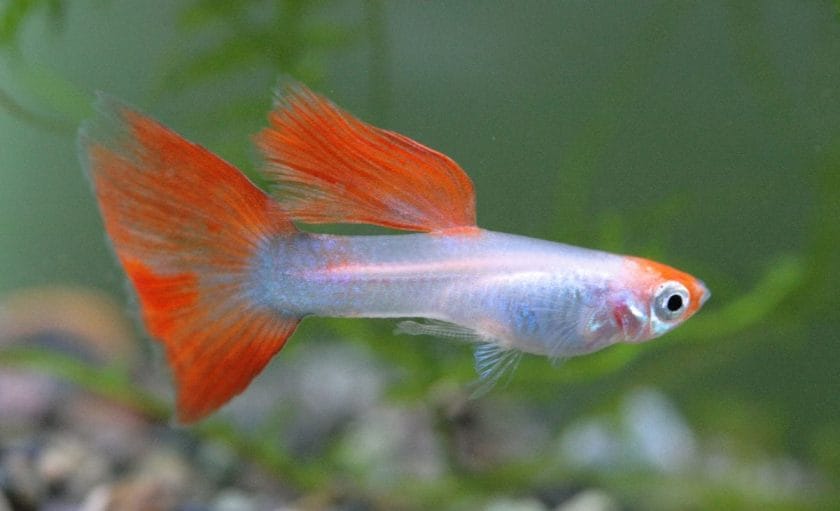
Dela tail guppies have a triangular tail that showcases the guppy’s colors and patterns.
Fantail Guppies
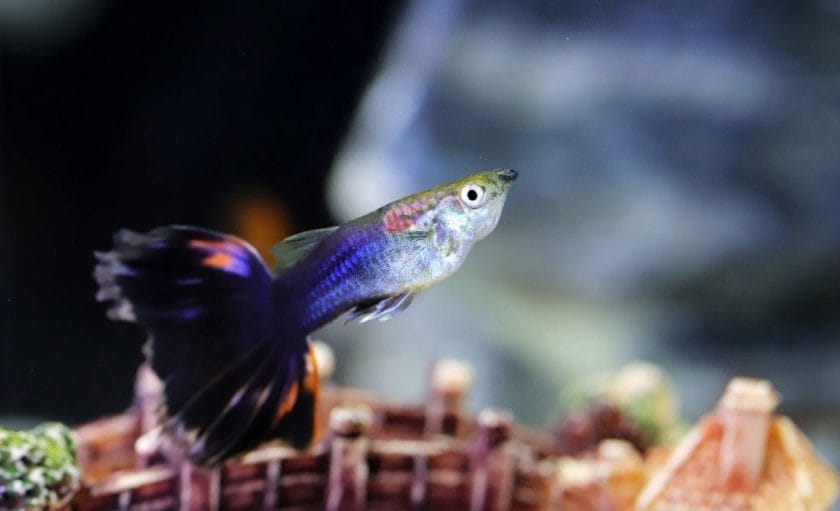
Fantail guppies have tails that look like a fan with elongated dorsal fins. The ventral fins on fantail guppies are generally smaller.
Roundtail Guppies

A roundtail guppy has a tail that’s a little shorter but is distinctly symmetrical and round, making it an aesthetic choice for breeding. This shape is very similar to that of wild guppies.
Flagtail Guppies
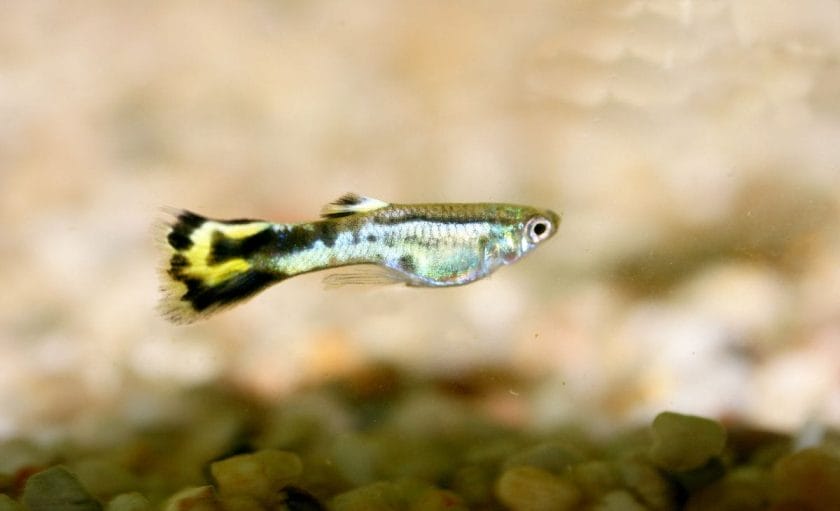
Flagtail guppies, also known as scarftail guppies, have broader tails with narrower edges. This type of tail configuration is exceedingly rare and is thought to be a mutation of the delta tail trait.
Swordtail Guppies
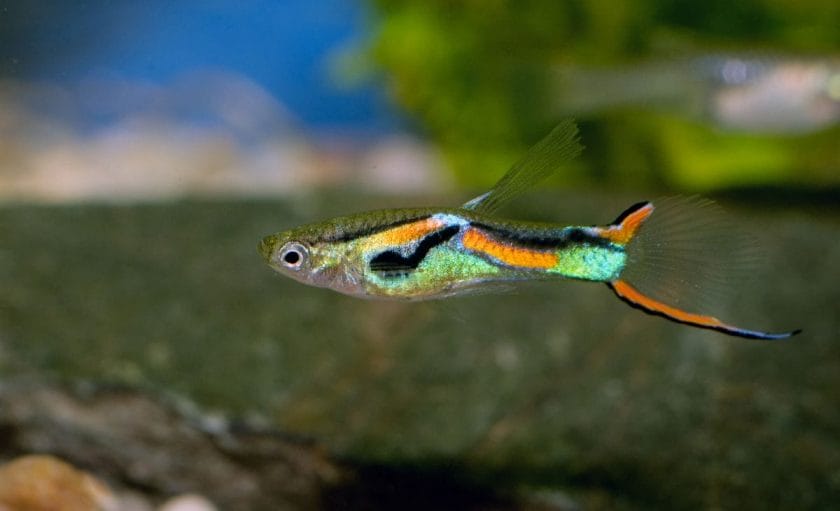
A swordtail guppy has a singular elongated edge on the top or bottom of the tail in a distinctive prong. This gives the guppy a sleek, sharp look. If a guppy has a singular prong at the top or bottom, they are referred to as a Top Swordtail or Bottom Swordtail, respectively.
Double Swordtail Guppies
Similarly, a double swordtail guppy has two distinct prongs on its tail, elongated on the top and base of the tail, while the center is short and broad.
Lyretail Guppies
The lyretail guppy is a variation of the double swordtail guppy, except that the tails are not independent but are rather connected by a thin membrane. This is especially beautiful when guppies flare their tails.
Needle Tail Guppies
Short and sleek, the needle tail guppy has a short tail with a distinct needle-like protrusion from the center. This tail type is also sometimes referred to as a pintail.
Spear Tail Guppies
Spear tail guppies are similar to needletail guppies, except that the protrusion from the center of the tail is less acute in appearance.
Spade Tail Guppies
Also called a cofer tail, the spade tail has broad, flat sides that converge into a point, much like the blade of a shovel.
Guppy Tail Coloration
Aside from the shape of their tails, guppies may also have different coloration patterns in their tails that are a mark of their breeding. These genetic traits can significantly change the look of a guppy, especially given the range of colors, tail types, and patterns that guppies can exhibit.
Glass Tail Guppies
A glass tail guppy has a transparent tail due to the absence of guanine. Glass tail guppies may be less metallic in appearance. Additionally, glass tail guppies may be melanin deficient, affecting their appearance even more.
Leopard Guppies

Put simply, leopard tail guppies have speckled dark spots on their tails that make them resemble the coat of a leopard. The spots are usually darker, which is why leopard tails are often adored for their high-contrast colors, especially against lighter shades.
Mosaic Guppies
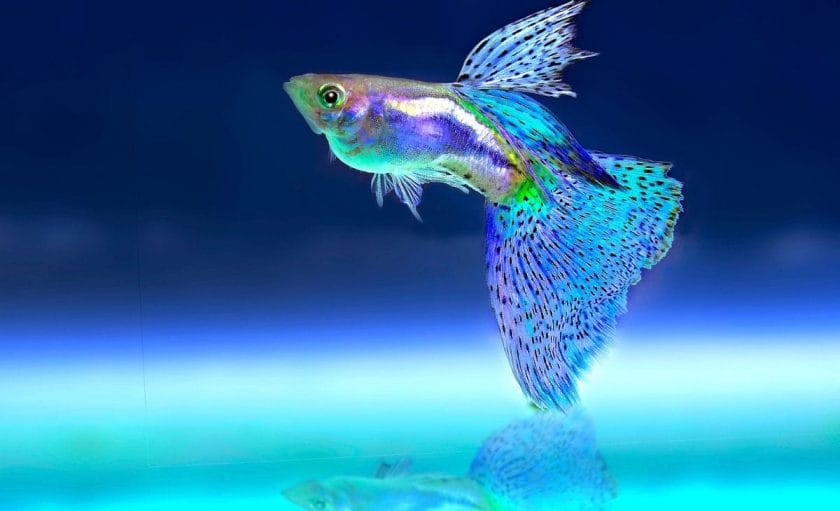
Mosaic guppies have a kaleidoscope-like appearance in their tails, with irregular dots, speckles, and striations. This tail type is striking and gorgeous, as the colors blend in unique and remarkable ways.
Lace Guppies

Lace guppies have a delicate appearance, and lace tails are often associated with snakeskin guppies, giving them an overall speckled appearance from head to tail. Tails are usually fan-shaped and are especially beautiful in a gradient.
Guppy Patterns
When people refer to guppy types, they are usually referring to the myriad of beautiful and complex color patterns that have been bred into guppies.
Generally, males will be the ones to exhibit these traits, while the females will not, or, if they do, to a much lesser extent.
Tuxedo Guppies

Tuxedo guppies have two complementary colors on the front and back of their bodies. The front is usually lighter, while the posterior is darker. The striking contrast makes these guppies highly sought after.
Generally, black is contrasted with another color.. Either of these colors can appear as a gradient, which can be a distinguishing feature.
Some tuxedo guppy combinations include:
- Black-green
- Black-blue
- Black-yellow
- Black-red
- Black-pastel
Cobra Guppies
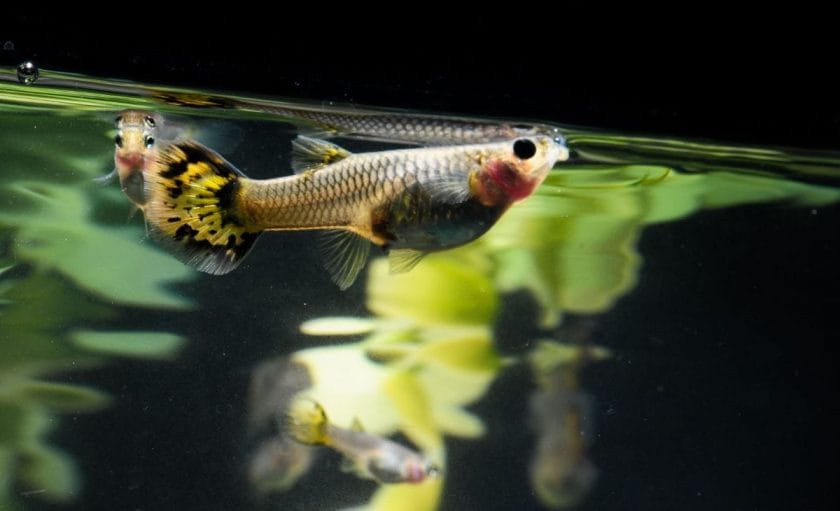
Cobra guppies have speckles and spots all over their body that may be white, black, green, or orange, among other colors. Vertical striations are distinct and may be more visible with certain color combinations.
Cobra guppies are sold in many different formats, including red, yellow, blue, green koi, lemon, gold, and dragon, each with their own distinct markings.
Snakeskin Guppies
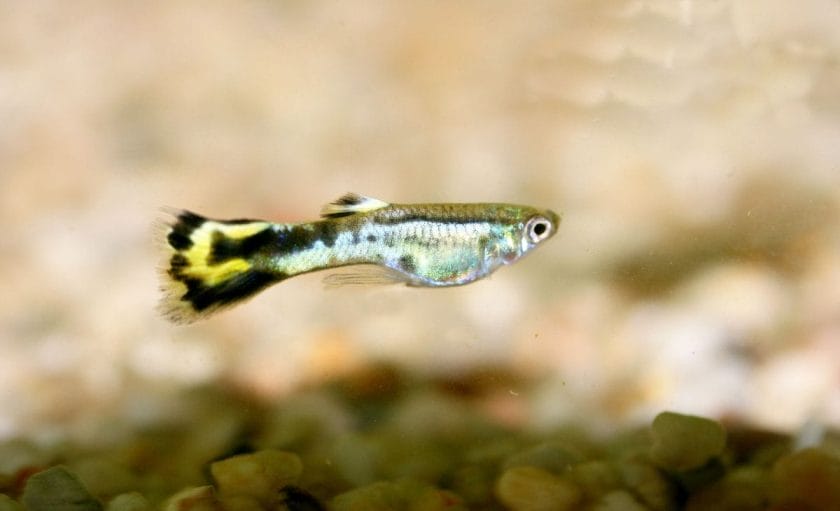
Snakeskin guppies are very similar to cobra guppies, to the point that aquarists can easily conflate the two. They have dense spots throughout their body, which provide a nuanced and accentuated color pattern that may be gold, black, or orange.
Guppy Colors
Not only are tail types and colors considered, but breeders may try to target certain colors, some of which are much harder to breed than others. Albino guppies, for example, often appear delicate for their pinkish hues and muted colors.
White and black guppies are usually monochromatic and striking, while a blue guppy may appear neon, electric, or sky-blue, depending on the breeding. Red guppies have a dominant red color, even their eyes, although color variations may make the guppy appear orange in some lights.
Guppies may need to meet certain standards to fit in a color category. Bronze and gold guppies must be at least 25% of their titular color; the former must have black scales as well.
There are many combinations with black when it comes to guppy coloration, including the following:
- Black-green
- Black-purple
- Black-blue
- Black-red
- Black-pastel
- Black-yellow
Naturally, guppies can be dichromatic or multicolored.
Albino Guppies
Albino guppies are white all over, with yellow coloration near the face and pinkish-red eyes. The albino gene is particularly hard to extract, so they are quite rare and highly sought after.
White Guppies
White guppies have a milky base color and black eyes, distinguishing them from albino guppies. While a guppy can still be classed as white if it has secondary colors, breeders typically aim for a monochromatic color.
Black Guppies
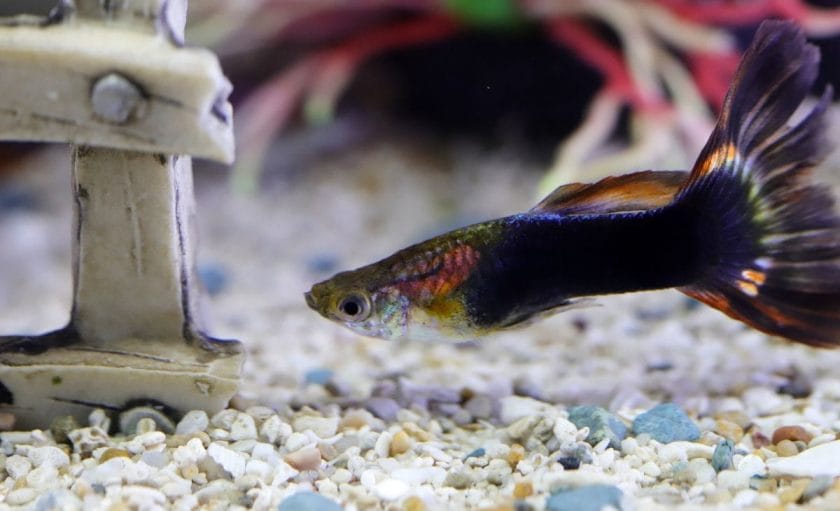
Richly colorful, black guppies have a charcoal black coloration, ideally through their whole bodies–even their eyes! As they grow, black guppies may start to appear mottled as they age, displaying dark grey coloration.
Red Guppies
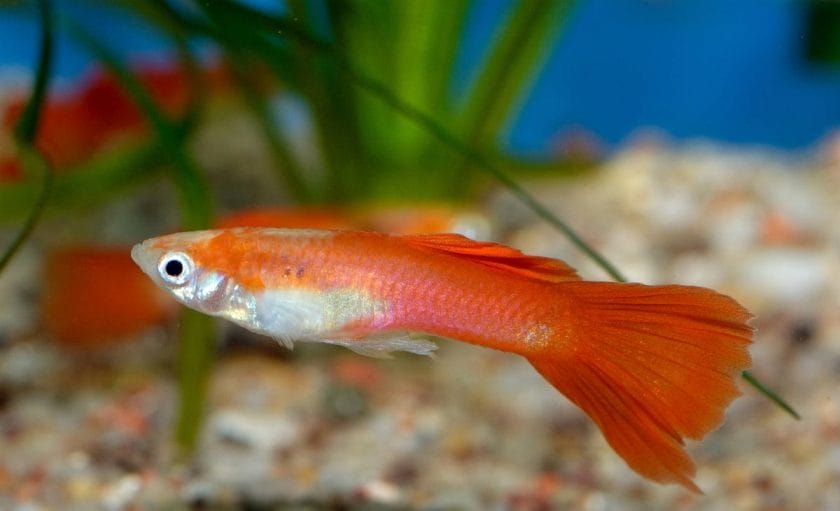
As confusing as it may seem, red guppies range in color from maroon to gold, as they usually have some purple, blue or black as underlying colors. Still, these colors are beautiful with different patterns and appear striking under different lights.
Yellow Guppies

Yellow guppies have the blonde gene to mute some of the darker colors in the strain and may have metallic undertones that highlight the golden hues of the blonde gene.
Golden Guppies
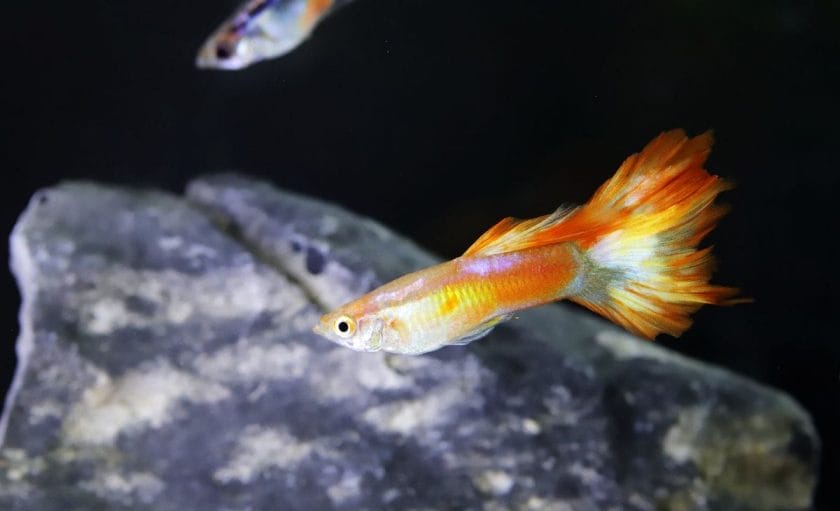
Unlike bronze guppies, which have black markings, golden guppies must have at least 25% yellow scales and appear in various shades of yellow.
Bronze Guppies

Bronze guppies must have 25% golden body scales, except, unlike golden guppies, they must be lined with black. Breeders will often highlight the bronze coloration with red or green bi-colored tails.
Japanese Blue Guppies
Japanese Blue Guppies show similar colorations to blues in nature, with striking light-blue coloration often on their tails or the rear of their bodies. They are usually multicolored and are bred as swordtails.
Blue Guppies

From pale blue to midnight blue, these guppies are distinct in different lighting, as their iridescent sheen shows up differently. They may also appear purple in some lights.
Purple Guppies
From violet to magenta, purple guppies are relatively new to the breeding world and are extremely expensive. This purple coloration appears often on the dorsal fin and tail.
Neon Blue Guppies
Unlike traditional blue guppies, neon blue guppies have a striking metallic sheen that makes them look electric blue.
Green Guppies
The rarest strain of guppy color, green is profoundly difficult for breeders to achieve and makes for a beautiful appearance. Most are actually blue/green guppies, as breeding true green is very challenging.
Multicolored Guppies

As the name suggests, multi guppies have numerous coloration throughout their body. Specifically, multicolored guppies have three different colors in their tails and dorsal fins.
Metal Guppies

Metal guppies have an unmatched sheen that is truly captivating. The light reflects off their body in a myriad of shimmering colors. Their bodies are generally a charcoal black with a lighter underbelly and distinct metallic shimmers on their body and tails.
Koi Guppies
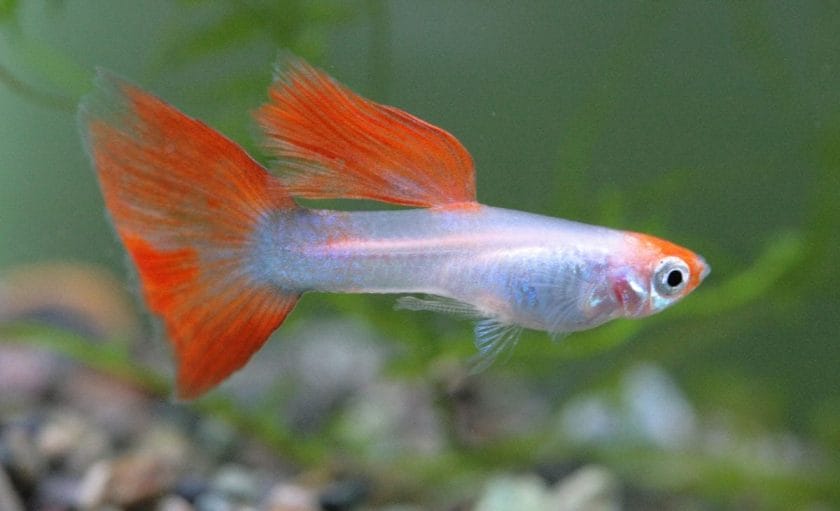
Koi guppies exhibit the classic koi coloration, with an orange head, darker body, and orange fins. Of course, albino koi guppies have a white body instead. Sometimes, these features manifest in females as well.
Koi guppies generally have a tuxedo pattern, but may come in other variations, too.
Moscow Guppies
Rare and expensive, Moscow guppies are artificially selected for their desirable colors. They often have distinct colors, shapes, and fin sizes.
Distinctively, these guppies are monochromatic, have deep, rich colors, and have flowing fins and a halfmoon tail. They may come in black, red, green, or purple, with purple being one of the hardest to obtain and even harder to breed.
Panda Guppies
Panda guppies have a distinct black color around the eyes, dorsal fin, and tail. Generally, they look similar to tuxedo guppies, except that their coloration is limited to the eyes, dorsal fin, and tail in most cases.
Platinum Guppies

A hybrid species, platinum guppies have truly stunning silver scales and red albino fins. Mostly, platinum guppies are plain but may have iridescent blues and purples near the tips of their fins. Some reds and yellows in the body are common.
Dragon Head Guppies
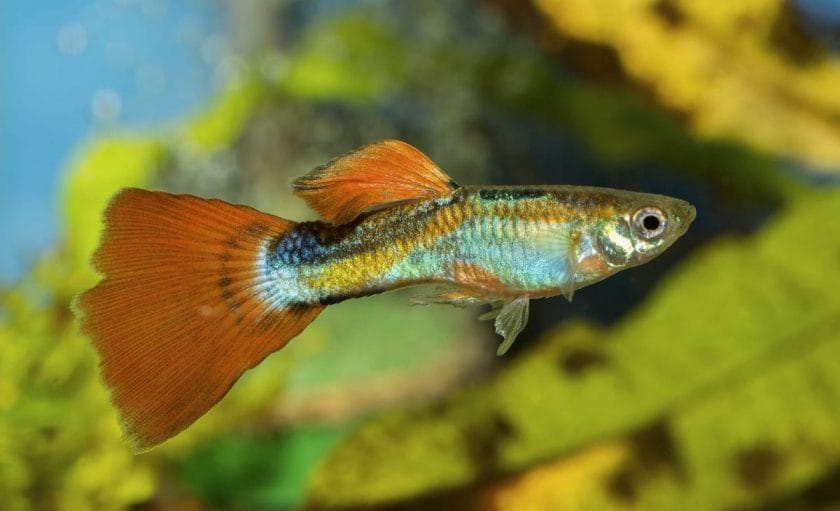
Dragon guppies may have shades of blue, red, orange, violet, and yellow. They are distinct for their iridescent bodies and dramatic color schemes.
Jarawee Lazuli Guppies
Named for the aquamarine lapis lazuli, the Jarawee has an electric neon blue head. They generally have double swordtails, making this species look striking, sharp, and elegant. Speckles of color throughout make this species distinctly colorful.
Dumbo Guppies
Dumbo guppies have long pectoral fins that resemble giant ears. These fish generally have a hard time swimming because their fins are impractically large.
Mutt Guppies

Mutt guppies are a mix of colors, tail types, and patterns that don’t fit into any given category. Generally, there’s nothing wrong with mutt guppies; they just aren’t suited for showing in a particular category.
You can still find many beautiful mutt guppies with gorgeous colors that breeders sell to reduce their stocks.
Where to Find Your Preferred Guppy Type
Regardless of whether you’re planning to breed or just enjoy watching your guppies, it’s important to source them through a reputable breeder. To do so, you can use several ‘filters’ to check whether a company is legitimate or not.
Reputation
Online or not, reputation is important. Shopping at a local guppy breeder near you is a smart move since it allows you to get a first-hand impression of how the guppies are raised, and you can utilize third-party review websites to determine whether the business has a good rapport with customers.
Online, you’ll want to be especially wary of scams, as purportedly rare guppies are sold at a high price, only for the buyer to receive a guppy that does not exhibit those rare traits–if they receive anything at all. As such, you should exercise caution and do your research.
Common sense practices still apply; if a website seems poorly designed, has inconsistencies, and makes promises that seem too good to be true, then buyers beware.
Ethicality
Another important indicator of a reputable breeder is ethical breeding. New species of guppies are constantly being introduced, and with some breeders, the emphasis is more on monetization than responsibility.
If you have a chance to visit, going in-person might be a good step. That way, you can not only confirm that the guppies are to your liking, but also that they are being ethically housed. Online, there’s really no way to tell besides using third-party review sites.
All in all, being cautious about promises made on the internet is always prudent, whether you’re shopping or not. Taking the time to do your research will always be time well spent and may help you avoid getting scammed.
FAQs
What Is the Rarest Guppy Type?
By species, swamp guppies are the rarest because they are more difficult to keep and breed. Since a wide combination of rare traits like tail type, body appearance, color patterns that are difficult to breed define rareness, it’s impossible to define the single rarest guppy.
How Many Guppy Types Are There?
There are over 50 types of guppies when combining species, tail type, and coloration. Of course, there are thousands of individual combinations of features, which is what makes guppies so beautiful and, sometimes, rare.
Do Female Guppies Have Color?
Some female guppies may have some of the same traits as the males, but generally not to the same extent. In some color patterns, the colors may be more noticeable.
Conclusion
Guppies make a beautiful addition to many tanks, and the near-infinite color variations mean that no two guppies are alike. When purchased from a reputable breeder, guppies are an excellent way to add some color and intrigue to your tank.
Be sure to pay attention to the many types of guppy tail types, colors, and variations so that you know exactly which guppy is right for you!